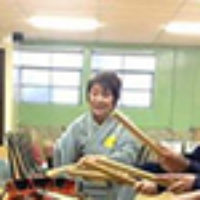
Mariko Watabe
Hayashi is a traditional Japanese percussion ensemble. Originating in Noh theater in the 14th century, hayashi also plays an important part in Kabuki theater. The core hayashi instruments are the kotsuzumi (a shoulder drum that produces low sounds), the okawa (a hand drum that makes very high sounds), and the taiko (a drum played with sticks). Additionally, there is a wide variety of percussion instruments and sound effect instruments that are used to supplement the hayashi ensemble.
Mariko Watabe began learning Japanese dance through the Bando School of Kabuki Dance in Japan in 1958. Through this school, she obtained the stage name of Marifuji Bando, as well as a teaching license, in 1968. In 1967, she began lessons in shamisen (three-stringed lute), and in 1974, after moving to California, began performing as part of the Kichisaburo Kineya Nagauta Company. Under this company, she received her stage name of Kichitoji Kineya in 1982, and later an instructor’s license. In 2000, after meeting hayashi musician Kikumi Katada, Mariko began travelling to Japan on a regular basis to take hayashi lessons. She received her stage name of Kimisen Katada, as well as her instructor’s license, from grandmaster and National Living Treasure Kisaku Katada.
As a master artist in ACTA’s Apprenticeship Program in 2017, Mariko Watabe will mentor Carlos Coronado to further his understanding of the hayashi tradition. They will focus on a specific 20-minute piece called “Kocho” (butterflies), which is an excerpt of the one hour composition called “Kagamijishi.”
As a master artist in ACTA’s Apprenticeship Program in 2015, Mariko worked with apprentice Amy Smith, building her skills in playing the okawa and taiko as part of a hayashi ensemble.
